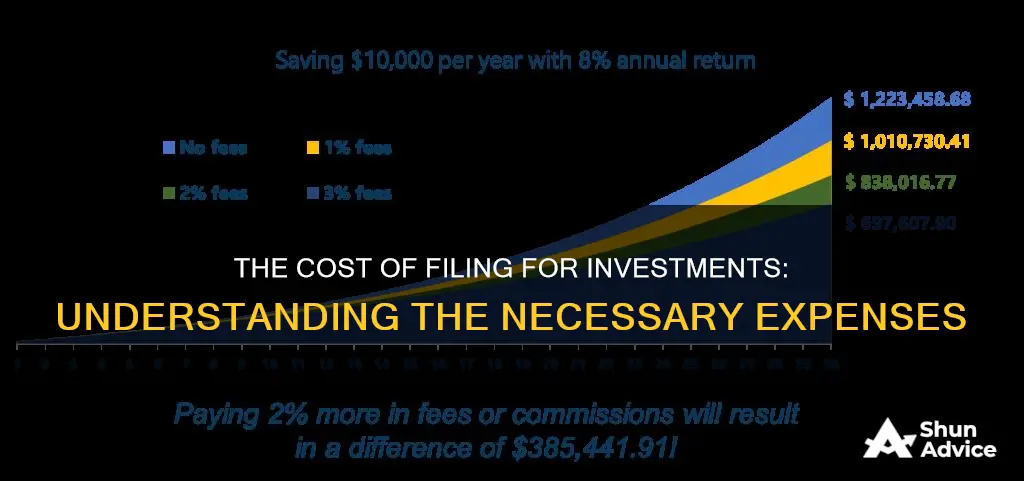
Investing is a great way to grow your assets, but it's important to understand the tax implications. Taxes on investments can vary depending on factors such as the type of investment, the length of time you hold it, and your income level.
In general, there are two main times when your taxes are affected by your investments: when you receive income from the investments and when you sell the investments for a gain or loss. The income you receive from investments, such as interest and dividends, is typically taxed at your ordinary income tax rate. However, certain dividends may receive special tax treatment and be taxed at lower long-term capital gains tax rates.
When it comes to selling investments, you usually only have to pay taxes on the sale if you make a gain. To calculate this, you subtract the cost basis of the investment (what you paid for it) from the sale price. If there is a loss, you may be able to offset other gains or take a deduction, depending on your situation.
It's also important to note that different types of investments may have special tax treatments. For example, investments within tax-advantaged retirement accounts, such as traditional IRAs or 401(k)s, may allow you to take a tax deduction when you invest, and the investments can grow tax-free until you withdraw the money in retirement. On the other hand, investments like collectibles (e.g. rare stamps, coins, art) typically have a higher long-term capital gains tax rate of 28%.
Additionally, investors may be subject to an additional Medicare surtax of 3.8% on investment income if their modified adjusted gross income exceeds certain thresholds.
| Characteristics | Values |
|---|---|
| Types of investment income | Dividends, capital gains, and interest |
| Tax forms | 1099-B, 1099-DIV, 1099-INT, Composite 1099, Schedule D |
| Capital gains tax rate | 0% to 20% for long-term, ordinary income tax rate for short-term |
| Capital loss deduction | Up to $3,000 of net capital losses against other taxable income each year |
| Dividend tax rate | 0%, 15%, or 20% for qualified dividends, ordinary income tax rate for non-qualified dividends |
| Interest income tax rate | Ordinary income tax rate |
| Tax-deferred accounts | 401(k)s, IRAs, HSAs, Roth IRAs |
| Mutual fund distributions | Reported on Form 1099-DIV |
| Federal tax consequences | Set aside money each month, earmark assets in a low-risk or liquid account |
| Installment plan for tax payments | IRS Form 9465 |
What You'll Learn
- Capital gains tax: Profits from the sale of assets, such as stocks or property, are generally taxable. The rate depends on how long the asset was held
- Dividend tax: Dividends are usually taxable as income in the year they are received. Non-qualified dividends are taxed at regular income rates, while qualified dividends have a lower rate
- Taxes on investments in a 401(k): Taxes on traditional 401(k)s are paid when money is withdrawn, while Roth 401(k)s are taxed upfront
- Mutual fund taxes: Taxes on mutual funds include taxes on dividends, interest, and capital gains distributed by the fund
- Tax on the sale of a house: The sale of a primary residence may result in a taxable capital gain if it exceeds certain thresholds

Capital gains tax: Profits from the sale of assets, such as stocks or property, are generally taxable. The rate depends on how long the asset was held
Capital gains tax is a tax imposed on the profits from the sale of an asset. The rate of tax depends on how long the asset was held for, with different rates for assets held for longer or shorter than one year.
Long-term Capital Gains Tax
Long-term capital gains tax is a tax on profits from the sale of an asset held for more than a year. The rates are 0%, 15%, or 20%, depending on your taxable income and filing status. Most people pay no more than 15% on their realised long-term capital gains. Long-term capital gains tax rates are typically lower than your ordinary income tax rate.
Short-term Capital Gains Tax
Short-term capital gains tax is a tax on profits from the sale of an asset held for one year or less. Short-term capital gains are taxed according to your ordinary income tax bracket: 10%, 12%, 22%, 24%, 32%, 35%, or 37%.
Capital Losses
If you have a net capital loss, you may be able to offset other realised gains or take a deduction depending on your situation. If your capital losses exceed your capital gains, you can claim up to $3,000 per year to lower your income. Any excess loss that cannot be claimed can be carried forward to future tax years.
Should You Invest in GE Now?
You may want to see also

Dividend tax: Dividends are usually taxable as income in the year they are received. Non-qualified dividends are taxed at regular income rates, while qualified dividends have a lower rate
Dividends are usually taxable as income in the year they are received. However, dividends can be either non-qualified or qualified, and these two types are taxed differently.
Non-qualified dividends are taxed at regular income rates, which can reach a high of 37%. Non-qualified dividends include those that do not meet the requirements of a qualified dividend, capital gains distributions, dividends paid on bank deposits, dividends from tax-exempt corporations or farmers' cooperatives, and dividends paid to an ESOP (Employee Stock Ownership Plan).
Qualified dividends, on the other hand, are taxed at lower long-term capital gains rates of 0%, 15%, or a maximum of 20%. To be considered qualified, a dividend must meet certain requirements set by the IRS. For example, the dividend must be paid by a US corporation or a qualified foreign corporation, and the shareholder must meet the holding period requirement of having held the stock for at least 60 days during a 121-day period that begins 60 days before the ex-dividend date.
Holding dividend-paying investments inside a retirement account can be a way to defer taxes on investments. Additionally, investors only pay taxes on dividends paid by stocks held directly or in a regular brokerage account. Dividends paid by stocks held in a tax-advantaged account, such as an IRA, are not taxable in the year they are received.
Dollar General: A Smart Investment Move?
You may want to see also

Taxes on investments in a 401(k): Taxes on traditional 401(k)s are paid when money is withdrawn, while Roth 401(k)s are taxed upfront
The 401(k) is a retirement savings plan that offers tax advantages to savers. There are two main types of 401(k)s: traditional and Roth. Each has distinct tax advantages, but they differ primarily in how and when they're taxed.
Traditional 401(k)
With a traditional 401(k), contributions are made with pre-tax dollars, meaning they are taken from your gross salary before income taxes are deducted. This reduces your taxable income for that year. Taxes are then paid on the money when it is withdrawn in retirement, and these withdrawals are taxed as ordinary income.
Roth 401(k)
With a Roth 401(k), contributions are made with after-tax dollars. This means that you don't get a tax deduction for the contribution at the time you make it. However, withdrawals are not taxed in retirement, provided certain conditions are met.
Gladstone Investment: Unlocking Monthly Dividend Potential
You may want to see also

Mutual fund taxes: Taxes on mutual funds include taxes on dividends, interest, and capital gains distributed by the fund
Mutual funds are taxed on dividends, interest, and capital gains distributed by the fund. These taxes can be broken down into a few key categories.
Dividends
Dividends are a part of the profits distributed amongst investors by mutual fund companies. Dividend income is generally taxed as ordinary income. However, there are two important exceptions: qualified dividends and tax-free interest. Qualified dividends are taxed at the lower capital gains tax rate, while tax-free interest is offered by some mutual funds that invest in government and municipal bonds.
Capital Gains
Capital gains taxes are incurred when investors sell their capital assets for a higher price than their total investment amount. The rate of taxation on capital gains depends on the holding period and the type of mutual fund. Mutual funds held for less than a year are considered short-term capital gains, while those held for longer are considered long-term capital gains. Long-term capital gains are taxed at lower rates than short-term capital gains.
Holding Period
The holding period is the time between the date of purchase and sale of mutual fund units. A longer holding period results in a lower tax amount. This is because the fund has held the investment within its portfolio for a longer period, and the difference between ordinary income and capital gains tax rates can be significant.
Fund Types
Taxation rules differ based on the type of mutual fund. For instance, equity funds are taxed differently from debt funds. Equity funds are those where more than 65% of the total fund amount is invested in equity shares of companies, while debt funds have a portfolio debt exposure of more than 65% and an equity exposure of not more than 35%.
Securities Transaction Tax (STT)
In addition to the taxes mentioned above, there is also the Securities Transaction Tax (STT). This is charged when you buy or sell mutual fund units of equity funds or hybrid equity-oriented funds, usually at a rate of 0.001% of the value of the transaction.
Timing and Frequency of Distributions
Mutual funds in retirement and college savings accounts are tax-advantaged, meaning you only pay taxes when earnings or pre-tax contributions are withdrawn. For mutual funds in taxable accounts, you must pay taxes on distributions, whether paid out in cash or reinvested in additional shares. These distributions typically occur at the end of each year when net amounts are calculated.
Tax Strategies
When considering tax strategies for mutual funds, it is important to keep in mind the timing of fund purchases and sales relative to distributions. Buying shares in a fund just before a distribution occurs will result in paying taxes on gains from shares throughout the year, even if you did not own the shares for the full year. Selling a fund prior to a distribution will generally result in a smaller tax bill. Additionally, funds with a lower turnover rate may be preferable as funds that trade securities frequently may accumulate more taxable gains.
Renewable Energy's Return: Does Green Energy Pay Dividends?
You may want to see also

Tax on the sale of a house: The sale of a primary residence may result in a taxable capital gain if it exceeds certain thresholds
When selling a primary residence, the profit is generally defined as the difference between the purchase price and the sale price. This profit is then potentially subject to capital gains tax. However, there are certain thresholds and exemptions that can be applied.
In the US, if you are single, you can exclude up to $250,000 of capital gains from your income. For married couples filing jointly, this exclusion doubles to $500,000. This exemption can be used once every two years.
To qualify for this exclusion, you must meet both the ownership and use tests. This means that you must have owned and used the property as your main home for at least two years out of the five years prior to the date of sale. The two years do not need to be consecutive, and there are certain exceptions for specific circumstances, such as a job change or health problems.
If you sell your home for a profit that exceeds the exclusion threshold, you will need to report the sale on your tax return and pay capital gains tax on the amount that exceeds the threshold. The capital gains tax rate depends on your income tax bracket, how long you have owned the house, and whether it was your primary residence, a secondary residence, or an investment property.
For example, if a married couple purchased a home for $400,000, lived in it for 30 years, and then sold it for $1,200,000, they would have a profit of $700,000 after subtracting $100,000 for capital improvements. Since this profit exceeds the exclusion limit of $500,000, the portion of the gain above the limit ($200,000) will be subject to capital gains tax. Assuming this couple's income puts them in the 15% long-term capital gains tax bracket, they would owe $30,000 in capital gains taxes.
It is important to note that the capital gains tax exclusion only applies to the sale of a primary residence. If you sell a secondary home or investment property, different rules and tax rates may apply.
Investing in People: Definition and Impact
You may want to see also
Frequently asked questions
There are several types of investment income, including dividends, capital gains, and interest.
Taxes are due at the time you earn money from your investments. If you sell investments at a profit, you will usually have to pay taxes on that profit. Taxes on investments that pay you a distribution may also be due.
To calculate the taxes you owe, you must first determine what type of income you earned. Then, you can use the appropriate tax forms to report your investment income when you file your tax return.
Yes, there are a few special considerations for taxes on investments. For example, if you have a retirement or college account like an IRA or 529 plan, the tax treatment of your earnings may be different. In some cases, you won't owe taxes on earnings until you withdraw money from the account or not at all. Additionally, the type of investment and how long you held it can impact the tax rate you pay.







